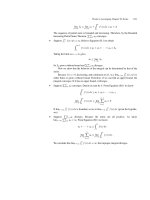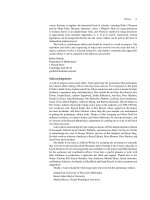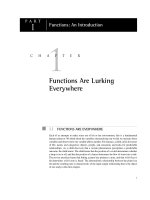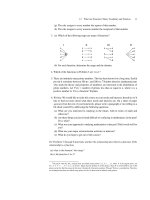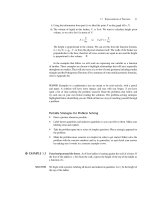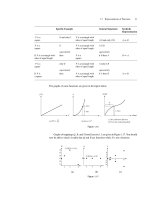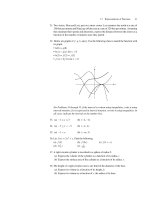Calculus: An Integrated Approach to Functions and their Rates of Change, Preliminary Edition Part 59 docx
Bạn đang xem bản rút gọn của tài liệu. Xem và tải ngay bản đầy đủ của tài liệu tại đây (249.47 KB, 10 trang )
18.1 Geometric Sums 561
Calculating how many milligrams are in the body one week later requires simple addition.
There are only eight terms, so entering them into a calculator is not too much work.
The second question, how many milligrams will be in the body after several years of
taking a 0.04 mg pill every morning, is certainly an important one, but at first glance it
looks like it will be a lot of work. Several years is not a well-defined period of time, but
if we figured on about three years, with a pill taken every day of the year, we must sum
(365)(3) = 1095 terms, 1096 terms if we look immediately after that 1096th pill is taken.
The prospect of adding these terms up is not particularly appealing, nor is the prospect of
writing them down.
But a mathematician would not become despondent at this prospect. Mathematicians
look for patterns, and there is a pattern to this sum. The challenge is how to exploit this
pattern to cut down on the workload. After three years, immediately after the 1096th pill is
taken, the number of milligrams of digitalis in the body is
.04 + (.7)(.04) + (.7)
2
(.04) + (.7)
3
(.04) +···+(.7)
1095
(.04).
We can use a “+ ···+” precisely because there is a pattern. Each term (from the second
one on) is (0.7) times the previous term. The ratio of one term to the previous term is
constant. Sums with this characteristic are called geometric sums, and we will see that this
characteristic makes it a real pleasure to add up a geometric sum.
A finite geometric sum is a sum of the form
a + ar + ar
2
+ ar
3
+···+ar
n
,
where a denotes the first term and r is the constant ratio of any term to the previous term.
We’ll begin by exploiting the pattern in order to find the amount of digitalis in the body
immediately after the eighth pill. We use the strategy of giving a name to the thing we are
trying to find.
Let D = .04 + (.7)(.04) + (.7)
2
(.04) + (.7)
3
(.04) + (.7)
4
(.04) + (.7)
5
(.04)
+ (.7)
6
(.04) + (.7)
7
(.04).
Key Idea: If we multiply D by 0.7 we get something that looks very similar to D.
.7D = (.7)(.04) + (.7)
2
(.04) + (.7)
3
(.04) + (.7)
4
(.04) + (.7)
5
(.04) + (.7)
6
(.04)
+ (.7)
7
(.04) + (.7)
8
(.04)
Subtracting this equation from the previous one will make all but two terms disappear, and
we can solve for D.
D =.04 + (.7)(.04)+(.7)
2
(.04) +(.7)
3
(.04) +(.7)
4
(.04) +(.7)
5
(.04) +(.7)
6
(.04) +(.7)
7
(.04)
.7D = (.7)(.04) +(.7)
2
(.04) +(.7)
3
(.04) +(.7)
4
(.04) +(.7)
5
(.04) +(.7)
6
(.04) +(.7)
7
(.04) +(.7)
8
(.04)
D − .7D =.04 + 0 +0 +0 +0 +0 +0 +0 −(.7)
8
(.04)
.3D =.04 − (.7)
8
(.04)
D =
.04−(.7)
8
(.04)
.3
=
.04[1−(.7)
8
]
.3
≈ 0.1256 mg
562 CHAPTER 18 Geometric Sums, Geometric Series
(This answer will agree with what you would obtain by adding up the eight terms individ-
ually.)
We can use the same technique to figure out the number of milligrams of digitalis in
the body three years later, immediately after the 1096th pill. Let’s call what we are trying
to find S, multiply S by 0.7, subtract the latter equation from the former, and solve for S.
Let S = .04 + (.7)(.04) + (.7)
2
(.04) + (.7)
3
(.04) +···+(.7)
1095
(.04)
.7S = (.7)(.04) + (.7)
2
(.04) + (.7)
3
(.04) +···+(.7)
1095
(.04) + (.7)
1096
(.04)
S − .7S = .04 − (.7)
1096
(.04)
.3S = .04 − (.7)
1096
(.04)
S =
.04−(.7)
1096
(.04)
.3
=
.04[1−(.7)
1096
]
.3
≈ 0.1333
So three years later, immediately after taking his pill, the man has about 0.1333 mg of
digitalis in his body. (Right before taking that 0.04-mg pill he must have had about 0.0933
mg of digitalis in his body.)
The question at the beginning of this section asked “How many milligrams will be in
the body several years later, assuming that the drug continues to be taken regularly?” We
figured out how many milligrams would be in the body three years later. Suppose we decided
to look at the situation after five years of regular medication, immediately after the 1827th
pill.
2
Let’s name the sum F , then multiply F by 0.7, the ratio of the terms, and subtract the
latter from the former.
F = .04 + (.7)(.04) + (.7)
2
(.04) + (.7)
3
(.04) +···+(.7)
1826
(.04)
.7F = (.7)(.04) + (.7)
2
(.04) + (.7)
3
(.04) +···+(.7)
1826
(.04) + (.7)
1827
(.04)
.3F = .04 − (.7)
1827
(.04)
F =
.04−(.7)
1827
(.04)
.3
=
.04[1−(.7)
1827
]
.3
≈ 0.1333
As you can see, the issue of whether “several” years is closer to three years or five years
is a moot one. In both cases a TI-83 calculator will give an answer of 0.1
3. Why should this
be? Let’s look at the amount of digitalis left in the body from the very first pill three years
after it is taken. The amount is 0.04(0.7)
1095
, a number so small that the TI-83 won’t register
it; it is negligible. After five years on digitalis the sum total of the medication left in the
body from the first two years on the drug is less than 2 · (365) · (0.04)(0.7)
1095
because each
of the 2 · (365) doses have been in the body for three or more years.
3
This too is negligible;
it is less than 10
−100
.
◆
EXERCISE 18.1 Sketch a rough graph of D(t), the amount of digitalis in the man’s bloodstream, as a function
of time. You need not be overly concerned with the details but make sure that qualitatively
the picture reflects the situation.
2
(365 days/year)(5 yrs) = 1825, and there has to be at least one leap year in there, and then there is that last pill that he takes
in the morning. In fact, we’ll see that the difference between using 1825 and 1827 is negligible.
3
An alternative approach is to compute the following sum: .04(.7)
1095
+ .04(.7)
1096
+ ···+.04(.7)
1095+1826
gives the amount
of digitalis from the first three years that is still left at the end of five years.
18.1 Geometric Sums 563
Geometric sums are useful in many contexts. The mathematics is not limited to digitalis
pills; it can be applied by physicians prescribing any medication that is administered at
regular intervals and is eliminated by the body at a rate proportional to itself. Geometric
sums can be used by environmental scientists studying pollutants whose potency diminishes
exponentially over time and whose introduction into the environment occurs at regular
intervals. Geometric sums are important to investors in analyzing and comparing investment
schemes and to banks in calculating payments on loans and mortgages. And all this is in
addition to the fact that they have a mathematical beauty in their own right.
Finite Geometric Sums
Definition
A finite geometric sum is a sum of the form
a + ar + ar
2
+ ar
3
+···+ar
n
,
where r is the ratio of any term to the previous term and a is the first term. (Notice
that there are (n + 1) terms in the sum above; n is not the number of terms.)
The following are examples of geometric sums:
i)
1
2
+
1
4
+
1
8
+
1
16
+···+
1
2
50
=
1
2
+
1
2
1
2
+
1
2
1
2
2
+
1
2
1
2
3
+···+
1
2
1
2
49
a =
1
2
r =
1
2
n = 49
ii)
2
3
−
2
9
+
2
27
−···−2
−1
3
12
=
2
3
+
2
3
−
1
3
+
2
3
−
1
3
2
+
2
3
−
1
3
3
+···+
2
3
−
1
3
11
a =
2
3
r =−
1
3
n = 11
iii) 3 + 6 + 12 + 24 +···+3072
= 3 + 3(2) + 3(2)
2
+ 3(2)
3
+···+3(2)
10
a = 3 r = 2 n = 10
(We find n by writing 3(2
n
) = 3072 so 2
n
= 1024.
Solve for n.)
iv) .04 + (.9)(.04) + (.9)
2
(.04) +···+(.9)
7
(.04)a=.04 r = .9 n = 7
These sums have 50, 12, 11, and 8 terms, respectively.
Consider a sum of the form a + ar + ar
2
+ ···+ar
30
. We can write this sum in a
form that is computationally simpler to use by employing the strategy that worked so well
in Example 18.1. Name the sum, multiply by r, subtract the latter equation from the former
and solve for the original sum.
S = a + ar + ar
2
+···+ar
30
rS = ar + ar
2
+···+ar
30
+ ar
31
subtracting gives
S − rS = a − ar
31
(1 − r)S = a − ar
31
S =
a−ar
31
1−r
.
564 CHAPTER 18 Geometric Sums, Geometric Series
The expression
a−ar
31
1−r
is called the closed form of the sum a + ar + ar
2
+ ···+ar
30
. The
closed form is computationally much easier to deal with than is adding 31 terms! One of
the wonderful things about geometric sums is that they can be expressed in closed form.
To get any geometric sum into closed form, do the following.
1. Give the sum a name, like S, for instance.
2. Determine “r.” (For a geometric sum this can be done simply by dividing any term by
the previous one, the second by the first, for instance. Be sure to include signs.)
3. Subtract “r” times the sum from the original sum. All but two terms will drop out.
That’s the beauty of the thing.
4. Solve for S, and you’re done.
The idea here is not to memorize a formula for closed form; rather it is to be able to put any
geometric sum into closed form. Try this on the following example. Do the work on your
own before looking at the solution provided.
◆
EXAMPLE 18.2 Write the following geometric sum in closed form: −2 +
8
3
−
32
9
+···−2
4
3
100
.
SOLUTION Let’s call the sum S. r =
8/3
−2
=−
4
3
and a =−2.
S =−2+
8
3
−
32
9
+···−2
4
3
100
−
4
3
S =
8
3
−
32
9
+···−2
4
3
100
+ 2
4
3
101
(subtract)
1 +
4
3
S =−2 −2
4
3
101
S =
−2−2
4
3
101
1+
4
3
S =
−2−2
4
3
101
7
3
=
−2
1+
4
3
101
7
3
With the aid of a calculator, the right-hand side is easy to compute whereas the sum in its
original form would be quite tedious.
◆
PROBLEMS FOR SECTION 18.1
For Problems 1 through 17 determine whether or not the sum is geometric. Assume
“+ ···” indicates that the established pattern continues. If the sum is geometric,
identify “a” and “r.”
1. 1 − 10 + 100 −···+10
10
2. 0.3 + 0.33 + 0.333 + 0.3333 +···+0.333333333
3. 0.3 + 0.03 + 0.003 + 0.0003 +···+0.000000003
4.
2
3
+
2
9
+
2
27
+···+
2
6561
18.1 Geometric Sums 565
5.
2
3
+ 2 + 6 +···+2(3)
100
6. 1 +
1
2
+
1
3
+···+
1
100
7. 1 −
1
2
+
1
4
−
1
8
+···+
1
64
8.
2
3
+ 1 +
3
2
+···+
243
32
9.
3
2
−
3
4
+
3
8
−···−
3
2
6
10.
3
2
−
4
4
+
5
8
−···−
8
2
6
11. −a + a
2
− a
3
+···+(−a)
17
12.
1
e
+
2
e
2
+
4
e
3
+···+
2
n
e
n+1
13. −2 + 4 − 6 + 8 − 10 +···+16
14. −2 + 4 − 8 + 16 − 32 + 64
15. 0.2 + 0.06 + 0.018 + 0.0054 + 0.00162
16. 10 + 9.5 + 9 + 8.5 + 8 + 7.5 + 7 + 6.5
17. p + p
3
+ p
5
+ p
7
+ p
9
Express each of the sums in Problems 18 through 32 in closed form. Wherever possible,
give a numerical approximation of the sum, rounded off to 3 decimal places.
18. 1 − 10 + 100 −···+10
10
19.
3
2
−
3
4
+
3
8
−···−
3
2
6
20.
2
3
+ 2 + 6 +···+2(3)
100
21. 2e + 2e
2
+ 2e
3
+···+2e
12
22. 2e + (2e)
2
+ (2e)
3
+···+(2e)
n
23. −a + a
2
− a
3
+···+(−a)
n
24.
1
e
+
2
e
2
+
4
e
3
+···+
2
n
e
n+1
25. 5 + 15 + 45 +···+5·3
10
26.
2
3
+
1
3
+
1
6
+
1
12
+···+
1
3·2
100
27. 1 +
9
10
+
9
10
2
+
9
10
3
+···+
9
10
n
566 CHAPTER 18 Geometric Sums, Geometric Series
28. 1 +
11
10
+
11
10
2
+
11
10
3
+···+
11
10
200
29. −
5
2
+
5
v
−
10
v
2
+
20
v
3
−
40
v
4
+···+(−1)
n
5·2
n
v
n+1
30.
2
p
+
4
p
3
+
8
p
5
+
16
p
7
+···+
2
20
p
39
31. mq + m
2
q
4
+ m
3
q
7
+···+m
11
q
31
32.
1
x
−
1
x
2
+
1
x
3
−
1
x
4
+···−
1
x
10
Simplify your answer.
33. A ball is dropped from a height of 10 feet. Each time the ball bounces it rises to 70% of
its previous height. How far has the ball traveled when it hits the ground for the third
time? For the 12th time?
18.2 INFINITE GEOMETRIC SERIES
We know that we can find
1
2
+
1
4
+
1
8
+ ···+
1
2
n
for any finite n. We can let n be a million;
we can let n be a billion. What happens if we let n grow without bound? What sense can
we make of
1
2
+
1
4
+
1
8
+···+
1
2
n
+···?
Definitions
The terms of a sum are the numbers being added. We denote by a
1
, a
2
, a
3
, a
n
,the
first, second, third and nth term, respectively.
An infinite series, a
1
+ a
2
+ a
3
+ ···+a
n
+···,isthe sum of a sequentially
ordered infinite set of terms;
4
it is defined to be lim
n→∞
(a
1
+ a
2
+ a
3
+···+
a
n
).
If lim
n→∞
(a
1
+ a
2
+ a
3
+···+a
n
)=L,where L is a finite number, then the
series a
1
+ a
2
+···+a
n
+···is said to converge to L.
If lim
n→∞
(a
1
+ a
2
+ a
3
+ ···+a
n
)is unbounded or does not exist, then the
series is said to diverge.
The nth partial sum of the series is the sum of the first n terms and is denoted
by S
n
.Aninfinite series converges to L if and only if lim
n→∞
S
n
= L for some
finite number L.
A geometric series is an infinite series that can be written in the form a + ar +
ar
2
+ ar
3
+···+ar
n
+···,where a and r are constants.
Notice that the “+ ···+” after a
n
is shorthand for “and so on ad infinitum”;itis
shorthand for an infinite number of terms. We often write some general term before the
“+···”;this does not signify the end but simply a recipe for more terms.
4
The adjective “infinite” in “infinite series” refers to the number of terms to be summed.
18.2 Infinite Geometric Series 567
◆
EXAMPLE 18.3 What is
1
2
+
1
4
+
1
8
+···+
1
2
n
+···?
Your gut reaction to this may very well be “Hey, wait a minute! If we add an infinite number
of positive terms the sum will be infinite.” But think again, more carefully. A function can
be always increasing and yet bounded. (Draw such a function for yourself.)
SOLUTION Take One: Suppose I have a pie, a theoretical pie. I give you half of it, then half of what’s left
(I give you a quarter), then half of what’s left (I give you an eighth), and so on ad infinitum.
(We are assuming that a theoretical pie can be cut infinitely finely.) As I hand you pieces of
pie you accumulate more and more of the pie. The more slices I hand you, the closer you
will come to having the entire pie. You can come arbitrarily close to having the whole thing.
However, you will never have more than one whole pie. We want to say that in some sense
1
2
+
1
4
+
1
8
+···+
1
2
n
+···=1.
Let’s look at what is going on. After I hand you one piece, you have half the pie. After I
give you two pieces, you have
1
2
+
1
4
=
3
4
of the pie and
1
4
remains; when you have three
pieces, you have
1
2
+
1
4
+
1
8
=
7
8
and
1
8
remains. After I hand you the nth piece you have
1
2
+
1
4
+
1
8
+···+
1
2
n
of the pie and
1
2
n
remains. Look at the pattern.
1
2
1
2
+
1
4
= 1 −
1
4
=
3
4
1
2
+
1
4
+
1
8
= 1 −
1
8
=
7
8
1
2
+
1
4
+
1
8
+
1
1
6 = 1 −
1
16
=
15
16
1
2
+
1
4
+
1
8
+
1
16
+
1
32
= 1 −
1
32
=
31
32
1/2
3/4
7/8
15/16
31/32
Notice that because I keep splitting what I have left evenly with you, then if you have
1
2
+
1
4
+
1
8
+
1
16
+
1
32
, I must have
1
32
. You have the rest; you have 1 −
1
32
, the whole minus
the slice I have.
More generally, we find
1
2
+
1
4
+
1
8
+···+
1
2
n
= 1 −
1
2
n
.
568 CHAPTER 18 Geometric Sums, Geometric Series
Then lim
n→∞
1
2
+
1
4
+
1
8
+···+
1
2
n
= lim
n→∞
1 −
1
2
n
.
lim
n→∞
1 −
1
2
n
= 1. So
1
2
+
1
4
+
1
8
+···+
1
2
n
+···= lim
n→∞
1
2
+
1
4
+
1
8
+···+
1
2
n
= lim
n→∞
1 −
1
2
n
= 1.
We say that
1
2
+
1
4
+
1
8
+···+
1
2
n
+···converges to 1.
Take Two: We define
1
2
+
1
4
+
1
8
+ ···+
1
2
n
+ ··· as lim
n→∞
1
2
+
1
4
+
1
8
+···+
1
2
n
.
This limit can be computed by putting
1
2
+
1
4
+
1
8
+···+
1
2
n
in closed form.
S
n
=
1
2
+
1
4
+
1
8
+···+
1
2
n
1
2
S
n
=
1
4
+
1
8
+···+
1
2
n
+
1
2
n+1
1
2
S
n
=
1
2
−
1
2
n+1
S
n
= 2
1
2
−
1
2
n+1
= 1 −
1
2
n
So lim
n→∞
1
2
+
1
4
+
1
8
+···+
1
2
n
= lim
n→∞
1 −
1
2
n
= 1.
◆
◆
EXAMPLE 18.4 Does the series 2 + 4 + 8 + 16 + 32 + 64 +···+2
n
+···converge?
SOLUTION Clearly the series diverges. The numbers that we are summing are themselves growing
without bound, so the partial sums grow without bound.
Writing the nth partial sum in closed form we obtain
S
n
= 2 + 4 + 8 + 16 +···+2
n
2S
n
= 4+8+16 +···+2
n
+2
n+1
−S
n
= 2 − 2
n+1
S
n
= 2
n+1
− 2.
lim
n→∞
(2 + 4 + 8 + 16 +···+2
n
)=lim
n→∞
(2
n+1
− 2) =∞.This infinite series
diverges.
◆
Question: How can we determine which infinite geometric series converge and which
diverge?
Let’s look at the problem in general. Recall our convention that the very first term of
the series is “a” and the ratio of any one term to the previous term is “r”.
a + ar + ar
2
+ ar
3
+···+ar
n
+···= lim
n→∞
(a + ar + ar
2
+ ar
3
+···+ar
n
)
Our strategy for getting a handle on an infinite sum is to express the general partial
sum in closed form and to compute the limit as n increases without bound. We’ll give
18.2 Infinite Geometric Series 569
a + ar + ar
2
+ ar
3
+···+ar
n
the name P (for partial sum) and express the partial sum
P in closed form.
P = a + ar + ar
2
+···+ar
n
rP = ar + ar
2
+···+ar
n
+ ar
n+1
(subtract)
(1 − r)P = a − ar
n+1
P =
a−ar
n+1
1−r
for r = 1. We’ll look at the case r = 1 later; for now assume r = 1.
lim
n→∞
(a + ar + ar
2
+ ar
3
+···+ar
n
) = lim
n→∞
a − ar
n+1
1 − r
= lim
n→∞
a
1 − r
(1 − r
n+1
)
=
a
1 − r
lim
n→∞
(1 − r
n+1
)
What happens to r
n+1
as n →∞?
5
The answer depends on r.
If |r| < 1, then lim
n→∞
r
n+1
= 0. (Think of lim
n→∞
1
2
n
or lim
n→∞
−
1
2
n
.)
So (1 − r
n+1
) is finite if |r| < 1, in which case the limit is 1.
If |r| > 1, then lim
n→∞
r
n+1
=∞for r>1, and does not exist for r<−1.
(Think of lim
n→∞
2
n
and of lim
n→∞
(−2)
n
. The value of (−2)
n
oscillates wildly
between large positive and large negative numbers as n →∞.)
If r =−1, then lim
n→∞
r
n+1
does not exist since (−1)
n
oscillates between −1 and 1
as n →∞.
6
If r = 1, we cannot use the closed form for P given above. If r = 1, then we’re looking
at a + a + a + a + ···,sothe closed form for the sum of the first (n + 1) terms is
a(n + 1). lim
n→∞
a(n + 1) is finite only in the trivial case where a = 0. Therefore this
series diverges.
We can summarize our results as follows.
a + ar + ar
2
+···+ar
n
+···
converges to
a
1−r
for |r| < 1 and
diverges for |r|≥1.
EXERCISE 18.2 Consider the series 1 + x + x
2
+ x
3
+···+x
n
+···.
(a) For what values of x does this series converge? For these x-values, the series converges
to L(x). Find L(x).
(b) Compare the values of L(x),1+x,1+x+x
2
,and 1 + x + x
2
+ x
3
for each of the
following values of x.
i) x = 0.2 ii) x = 0.1 iii) x = 0iv)x=−0.1
5
We are letting n →∞through the integers.
6
When r =−1, the geometric series looks like a − a + a − a + ···.Ifwetally just the first term, we get “a”. If we tally the
first two terms, we get zero; the first three terms sum to “a,” etc. The partial sums oscillate between “a” and 0 indefinitely.
570 CHAPTER 18 Geometric Sums, Geometric Series
What do you observe about how well (or poorly) 1 + x + x
2
and 1 + x + x
2
+ x
3
approximate L(x) for each of these x-values?
◆
EXAMPLE 18.5 Let’s return to the digitalis problem from Example 18.1. We are interested in how much
digitalis is in the man’s bloodstream in the long run if he takes 0.04 mg every morning for
several years.
SOLUTION Suppose we choose to model the situation with an infinite series. If we want to know how
much digitalis is in the patient’s body several years later, right after he takes his medicine
we could calculate
.04 + (.7)(.04) + (.7)
2
(.04) +···+(.7)
n
(.04) +···.
This is a geometric series with a = 0.04 and r = 0.7. Since |r| < 1, the series converges to
a
1−r
=
.04
1−.7
=
.04
.3
= 0.1
3 mg. If we want to know how much digitalis is in the body several
years later, right before taking a pill it would be about 0.1
3mg − 0.04mg = 0.093 mg.
Using an infinite series in this situation may seem suspect. First of all, no matter how
effective digitalis is, no one will live forever, and secondly, “several” is a vague term. To
put this objection to rest, let’s look at the sum of all the “extra terms” we added. “Several”
years implies more than one, so the difference between the actual amount, a finite geometric
sum, and the infinite series we used is less than
(.7)
365
(.04) + (.7)
366
(.04) +···.
The latter is a geometric series with a = (.7)
365
(.04) and r = .7. Its sum is
a
1−r
or
(.7)
365
(.04)
1−.7
≈
3.85 × 10
−58
. This is extremely small, small enough in comparison to 0.4 to ignore.
◆
Using Infinite Geometric Series to Compute Finite Geometric Sums
Notice that it is comparatively less work to compute the sum of a convergent infinite
geometric series (identify a and r, verify that |r| < 1, and voil
`
a, the sum is
a
1−r
), than
it is to compute a finite geometric sum. If we have a finite geometric sum with |r| < 1, then
we can capitalize on our ability to sum an infinite geometric series easily. We demonstrate
this in the next example.
◆
EXAMPLE 18.6 Find the sum of 3 + 3(0.95)
2
+ 3(0.95)
4
+ 3(0.95)
6
+···+3(0.95)
20
.
SOLUTION This sum is geometric, so we identify “a” and “r”. a = 3 and r = (0.95)
2
.
Method I. Give the sum a name, like S for instance. Multiply S by r, subtract rS from S,
and solve for S.
Method II. |r| < 1, so the infinite geometric series 3 + 3(.95)
2
+ 3(.95)
4
+ 3(.95)
6
+
···+3(.95)
20
+···converges to
a
1−r
=
3
1−(.95)
2
≈ 30.769.
We are interested in a finite sum, so we cut off the tail of the series and subtract it from
30.769. The infinite geometric series 3(0.95)
22
+ 3(0.95)
24
+ 3(0.95)
26
+ ··· converges
to
a
1−r
where a = 3(0.95)
22
and r = (0.95)
2
. It converges to
3(0.95)
22
1−(0.95)
2
≈ 9.955. Therefore,
3 + 3(0.95)
2
+ 3(0.95)
4
+ 3(0.95)
6
+···+3(0.95)
20
≈ 30.769 − 9.955 ≈ 20.814.
Note that this method of computing a finite geometric sum by looking at the difference
of the sums of two infinite geometric series can only be employed in cases in which |r| < 1.
If |r|≥1wemust use Method I because the related infinite series diverge.
◆
